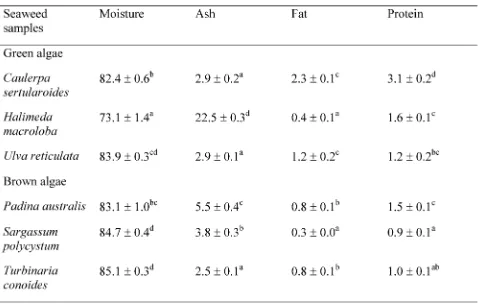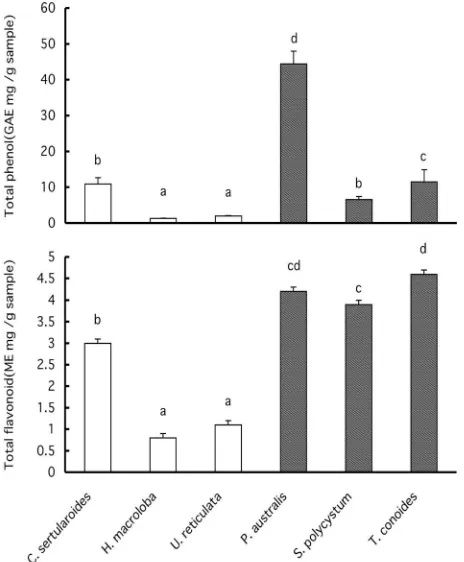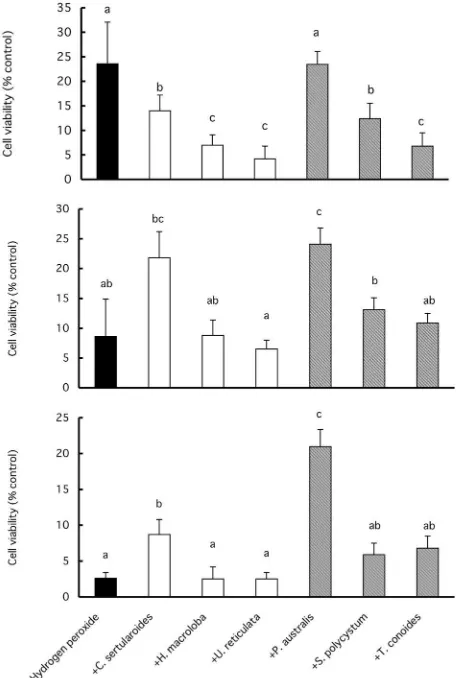Note
E
#
ects of Extracts from Tropical Seaweeds on DPPH Radicals and Caco-
,
Cells Treated
with Hydrogen Peroxide
Satoko GUNJI
+, Joko SANTOSO
,, Yumiko YOSHIE-STARK
+ῌand Takeshi SUZUKI
++Department of Food Science and Technology, Faculty of Marine Science, Tokyo University of Marine Science and Technology,
Tokyo, Japan
,Department of Fisheries, Bogor Agricultural University, Bogor, Indonesia
Received February+-,,**1; Accepted May1,,**1
Edible seaweeds were collected from Indonesia, a tropical country that does not show seasonal varia-tions in temperature, to evaluate their health-related activities. Ethanol and acetone extracts were prepared from-green and-brown algae. The ethanol and acetone extracts fromPadina australisshowed the strongest DPPH radical scavenging activity. These extracts also had the highest concentrations of total phenol and flavonoid. Both the ethanol and acetone extracts of the0Indonesian seaweeds decreased Caco-,cell viability when such cells were treated with0**mM hydrogen peroxide. However, when Caco-, cells were treated with1**or2**mM hydrogen peroxide, the ethanol and acetone extracts fromP. australis increased cell viability significantly more than those from the other seaweeds. This study indicates that organic extracts of seaweed have useful health-related functions.
Keywords : Seaweed, ethanol extract, acetone extract, DPPH radical scavenging activity, Caco-,, cell viability
Introduction
Seaweed is rich in minerals and dietary fiber, and sea-weed is a traditional food in Asia. In some reports, the health aspects of seaweed in relation to its soluble dietary fiber and mineral contents was mentioned (Wanget al., ,**+, Santosoet al., ,**0). Dietary fiber is found in the high-molecular-weight fraction of seaweed, while the low-molecular-weight fraction of seaweed is considered to contain substances such as free amino acids, solubilized minerals, and polyphenols (Wong and Cheung,,***, Yoshie
et al.,,***). In this study, we focused on evaluating the health-related activity of seaweed extracts mainly con-sisting of low-molecular-weight compounds.
Many studies have shown the radical scavenging and ACE inhibition activities of the water-soluble and organic-solvent-soluble fractions from seaweed (Junget al.,,**0; Satoet al.,,**,; Nahaset al.,,**1; Houet al.,,**-). Yuan
et al. (,**/b) and Yuan and Walsh (,**0) reported that seaweed extracts a#ect the proliferation of colon cancer cells. Radicals are present around tumors and inflam-matory tissue, among others. Therefore, radical scaveng-ing activity is considered to be useful for helpscaveng-ing to repair damage caused by inflammation.
The organic solvent-soluble fraction from seaweed con-tains compounds such as polyphenols and flavonoids. In addition, radicals are present throughout the human body.
Thus, thein vitroradical scavenging activity of organic extracts from seaweed and the e#ects of organic extracts from seaweed on the viability of cells treated with hydro-gen peroxide were selected to be evaluated in this study.
Materials and Methods
Materials Six edible Indonesian seaweed species were used in this study : three green algae (Caulerpa sertularoides, Halimeda macroloba,andUlva reticulata), and three brown algae (Padina australis, Sargassum polycystum,and Turbi-naria conoides). C. sertularoidesis known asUmibudoin Japan, andU. reticulatais similar to the Japanese Aosa. P. australisis similar to the Japanese seaweedUmiuchiwa,
but this tropical seaweed has a thinner and softer body than Japanese one. All seaweed samples used were ob-tained from the Seribu Island, Jakarta Prefecture, Indone-sia. They were washed with clean seawater and trans-ported to the laboratory under refrigeration. They were then washed with tap water, wiped with paper towels, and then minced with a food processor (MK-K1/; Matsushita Electric Co., Osaka, Japan), and stored atῌ,*῍C.
DPPH radical was purchased from Sigma Chemicals (St Louis, MO, USA). All the other reagents used in the experiments were of analytical grade.
Proximate analysis The chemical composition, i.e., moisture, ash, fat, and protein contents of the dried sea-weed samples, was analyzed in accordance with the AOAC method (AOAC,+33/).
Preparation of ethanol and acetone extracts Two
sol-ῌ
To whom correspondence should be addressed. E-mail : yumikoy@kaiyodai.ac.jp
vents, ethanol and acetone were used as solvents to pre-pare seaweed extracts. A five-fold volume of solvent (+**ῌethanol or+**ῌacetone) was added to a seaweed sample, the mixture was homogenized and collected su-pernatants (extracts) were evaporated, and then redissolved in the same solvent.
Determination of total phenol and flavonoid contents The acetone in the extracts was removed using nitrogen gas, and the extracts were then redissolved in ethanol prior to analysis. Total phenol contents in the ethanol and acetone extracts from seaweed samples were deter-mined following the method of Singleton and Rossi (+30/)
and Limet al.(,**,), with some modifications. Gallic acid
was used as the standard and the result was calculated as gallic acid equivalent (mg GAE/g dry sample). Total flavonoid content was analyzed following the method of Eberhardt et al. (,***) and Liu et al. (,**,), with some
modifications. As seaweeds have a high morin content (Yoshie-Starket al.,,**-), therefore, morin was used as a
standard. The results are expressed as miligrams of morin equivalents.
DPPH radical scavenging activity DPPH radical scav-enging activity was analyzed following the method ex-plained in the report of Yoshie-Starket al.(,**.).
Caco-,cell culture Human colon adenocarcinoma
Caco-,cells were obtained from the Institute of Physical and
Chemical Research (RIKEN Cell Bank, Ibaraki, Japan). Caco-,cells were cultured and maintained following the
report of Sugawaraet al.(,**+).
Treatment of Caco-, cells with hydrogen peroxide A hydrogen peroxide (H,O,) stock solution (3mol/L) was kept at.ῐC and diluted just before use in PBS bu#er (Ca
and Mg free). Cells (passages,*ῌ.*,/.*῍+*.
cells/mL,+**
mL/well) were seeded onto 30-well microplates and
in-cubated for,.h prior to H,O,treatment. The monolayer of cells was treated with 0mL of H,O, (to make final concentrations of0**,1**, and2**mmol/L) for,.h.
E#ect of seaweed extract on hydrogen peroxide treated Caco-,cells Cells (/.*῍+*
-cells/well) were seeded onto30
-well microplates (+**mL/ each well) and incubated for,.h.
Before H,O,treatment, the monolayer of cells was treated with0mL of a sample extract (,./mg sample equivalent/
mL at final concentration) for-*min. Then,0mL of H,O, (to make final concentrations of0**,1**, and2**mmol/L)
were added and the plates were incubated for,.h.
Cell viability Cell counting kit-2(Wako Pure
Chemi-cals, Osaka, Japan) was used for the cell viability assay. As mentioned above, cells were seeded onto30-well plates
and incubated for,.h before the test treatment. Then,
treatment with sample extracts and hydrogen peroxide or hydrogen peroxide alone was performed for,.h. For a
positive control (PC), MTT assay was performed with the addition of PBS instead of the sample extract. Ethanol was added to the treatment blank (B) instead of sample extract. After incubation, a water-soluble tetrazolium salt-based assay was performed as follows :+*mL of the cell
counting kit-2 solution was added to each well and
in-cubated for.h at-1ῐC under/ῌCO,. The absorbance at
./*nm was read using a microplate reader. Cell viability
was calculated as follows :
Cell viability (ῌ)῎(SῌB)/(PCῌB)῍+**
S : Absorbance from test sample
B : Absorbance of Blank (Ethanol was added instead of sample extract)
PC : Absorbance of positive control (PBS was added instead of sample extract).
Statistical analysis Results are presented as meanῌ
S.D. (n῎-ῌ/). ANOVA was used to calculate significant
di#erences.
Results and Discussion
Proximate analysis The proximate compositions of the seaweed samples are shown in Table+. H. macroloba had a significantly higher ash content than the other sea-weeds at a concentration of,,./g/+**g. The reason for
this high concentration of ash inH. macrolobais consid-ered to be the high calcium content needed to maintain this plant’s hard body. Among all of tested samples, only H. macrolobalives in a sandy shallow area and has a hard plant body. Green algae had a composition of1-.+ῌ2-.3g/ +**g moisture,,.3g/+**g ash,*..ῌ,.-g/+**g fat, and+.,ῌ
-.+g/+**g protein. Brown algae had a composition of 2-.+ῌ2/.+g/+**g moisture,,./ῌ/./g/+**g,*.-ῌ*.2g/+**g fat,
and*.3ῌ+./g/+**g protein.
Phenol and flavonoid contents Figures +and,
sum-marize the total polyphenol and flavonoid contents of the seaweed extracts. As shown in Fig.+, ethanol extracts
from green algae had a total phenol content of *ῌ+*mg
gallic acid equivalent (GAE)/g dry matter, whereas those from brown algae had a total phenol content of/ῌ./mg
GAE/g dry matter. Ethanol extracts from green and brown algae showed total flavonoid contents of*./ῌ-and -./ῌ../mg morin equivalent (ME)/g, respectively. P. au-stralisshowed a significantly higher phenol content than other seaweeds. Brown algae showed higher polyphenol and flavonoid contents than green algae. The total poly-phenol content (expressed as gallic acid equivalents) of the dulse andSargassummethanol extracts were reported
Table+. Proximate compositions of seaweed samples
(meansῌSD g/+**g).
to be+*.-mg GAE/g (Yuanet al.,,**/a) and/+.*mg GAE/ g (Lim et al., ,**,). With respect to the result of these studies,P. australisshowed a similar polyphenol content. As shown in Fig.,, acetone extracts from green and brown algae showed total polyphenol contents of*ῌ+*mg GAE/ g and 1ῌ/*mg GAE/g, respectively. Acetone extracts from green and brown algae showed total flavonoid con-tents of +ῌ,.2mg ME/g, and,./ῌ-mg ME/g, respectively. P. australisshowed a polyphenol content that was signifi-cantly higher than those of the other seaweeds. Jimenez-Escriget al.(,**+) reported that hydrolyzed and acetone/ water extracts showed phenol contents of.+..mg GAE/g forFucus, 1.-mg/g forLaminaria, 0.0mg/g for Undaria, and/.1mg/g forPorphyra. Compared with these values, P. australis showed significantly high contents of both polyphenol and flavonoid.
DPPH radical scavenging activity The DPPH radical scavenging activities of the ethanol extracts and acetone extracts from the seaweeds are shown in Fig.-. Ethanol and acetone extracts fromP. australisshowed significantly higher DPPH radical scavenging activities than those from the other seaweed samples. Total polyphenol con-tent and radical scavenging activity did not show a clear correlation ; however samples with a higher polyphenol content showed a higher radical scavenging activity.
Jimenez-Escrig et al. (,**+) reported the correlation be-tween polyphenol content and radical scavenging activi-ty. They also reported DPPH radical scavenging activity to have a median e#ective dose of-.*1mg sample/g DPPH with a polyphenol content of.+..mg GAE. Their poly-phenol content/DPPH radical scavenging activity ratio was similar to that in our results forP. australis,since the ethanol extract ofP. australisshowed a median e#ective dose (ED/*) of+.-mg of sample with a polyphenol content of./mg GAE/g, and the acetone extract of P. australis showed an ED/* of -mg of sample with a polyphenol content of/*mg GAE/g. Ethanol extracts of green sea-weeds showed significantly stronger radical scavenging activities than acetone extracts, whereas extracts from brown seaweeds did not show clear di#erence in radical scavenging activity between the two extraction solvents. Cell viability The viabilities of cells treated with0**ῌ 2**mM H,O, with and without treatment with ethanol
extracts from seaweeds are shown in Fig... When cells were treated with0**mM H,O,, cell viability became,.ῌ. Additional treatment with seaweed extracts did not in-crease cell viability ; it actually significantly dein-creased cell viability. However, when cells were treated with1**
mM H,O,, cell viability showed a significant increase with P. australisextract treatment. A higher concentration of Fig.+. Phenol (top) and flavonoid (bottom) contents of
ethanol extracts from0Indonesian seaweeds.
Total phenol content was calculated as gallic acid equiv-alent, GAE (mg/g dry sample), and total flavonoid content was calculated as morin equivalent, ME (mg/g dry sample). Letters over each column not sharing the same are signifi-cantly di#erent (Pῌ*.*/).
Fig.,. Phenol (top) and flavonoid (bottom) contents of
acetone extracts from0Indonesian seaweeds.
H,O, (2**mM) decreased cell viability ; however, in this case, the ethanol extracts from all the seaweeds showed a protective e#ect on the cells. In particular, ethanol ex-tracts from P. australis did not decrease cell viability during 0**mM H,O, treatment, and induced the largest increase in cell viability during 2**mM H,O, treatment. Similar results were found also with acetone extracts from the other seaweeds as shown in Fig./. The dulse, kelp,Porphyra, Gelidiumextracts were reported to inhibit cancer cell proliferation in a dose-dependent manner up to /.*mg/mL seaweed extract (Yuan and Walsh, ,**0; Cho et al.,+331). A correlation between the antiprolifera-tive e#ects of dulse and kelp extracts and the total poly-phenol content of the extracts has also been mentioned (Yuan and Walsh,,**0). In our results, cells treated with a low concentration of hydrogen peroxide showed a de-crease in cell viability during concurrent incubation with seaweed extracts. However, when cells showed a low cell viability owing to treatment with a high concentra-tion of hydrogen peroxide, the presence of seaweed ex-tracts increased cell viability. Some studies have used methanol extracts of seaweed ; others used butanol ex-tracts. The results from these reports and our study indicate that seaweed is a possible source of useful
anti-oxidative compounds and that di#erent compounds can be obtained as a result of the selection of the extraction solvent.
Conclusions Ethanol extracts from seaweeds were found to have interesting health properties. Specific fractions of seaweeds rich in polyphenol may a#ect DPPH radical scavenging activity. However, the e#ect of such fractions on cancer cell proliferation depend on the con-centration of hydrogen peroxide ; some e#ectively en-hance cell proliferation, and some through a combination of oxidative stress strength and extract concentration, reduce cell proliferation. Further research on organic extracts from seaweeds is necessary, to analyze not only with an analysis of the polyphenolic composition of each organic extract from the seaweeds, but also with an anal-ysis of their e#ects on normal cells.
Fig.-. DPPH radical scavenging activities of ethanol (top)
and acetone (bottom) extracts from seaweeds. ED/* was defined as/*ῌof the radical scavenging concentrations of dried sample (mg/mL).
Letters over each column not sharing the same are signifi-cantly di#erent (Pῌ*.*/).
Fig... Changes in H,O,-treated Caco-, cell viability in-duced by ethanol extracts from 0 Indonesian seaweeds. Cells were treated with 0**mmol/L H,O, (top), 1**mmol/L H,O,(middle), and2**mmol/L H,O,(bottom).
References
Association of O$cial Analytical Chemists. (+33/). O$cial methods of analysis. Washington, D.C.
Eberhardt, M.V., Lee, C.Y., and Liu, R.H. (,***). Antioxidant activ-ity of fresh apples.Nature,.*/,3*-ῌ3*..
Cho, E. J., Rhee, S.H., and Park, K.Y. (+331). Antimutagenic and cancer cell growth inhibitory e#ects of seaweeds.J. Food Sci. Nutr.,,,-.2ῌ-/-.
Jime´nez-Escrig, A., Jime´nez-Jime´nez, I., Pulido, R., and Saura-Calixto, F. (,**+). Antioxidant activity of fresh and processed edible seaweeds.J. Sci. Food. Agric.,2+,/-*ῌ/-..
Jung, H.A., Hyun, S.K., Kim, H.R., and Choi, J.S. (,**0). Angiotensin-converting enzyme I inhibitory activity of phlorotannins from Ecklonia stolonifera. Fisheries Sci.,1,,+,3,ῌ+,33.
Lim, S.N, Cheung, P.C., Ooi, V.E., and Ang, P.O. (,**,). Evaluation of antioxidative activity of extracts from a brown seaweed, Sargassum siliquastrum. J. Agric. Food Chem.,/*,-20,ῌ-200. Liu, M., Li, X.Q., Weber, C., Lee, C.Y., Brown, J., and Liu, R.H. (,**,).
Antioxidant and antiproliferative activities of raspberries. J. Agric. Food Chem.,/*,,3,0ῌ,3-*.
Nahas, R., Abatis, D., Anagnostopoulou, M.A., Kefalas, P., Vagias, C., and Roussis, V. (,**1). Radical-scavenging activity of Aegean Sea marine algae.Food Chemistry, in press.
Santoso, J., Gunji, S., Yoshie-Stark, Y. and Suzuki, T. (,**0). Mineral contents of Indonesian seaweeds and mineral solubil-ity a#ected by basic cooking.Food Sci. Technol. Res.,+,,/3ῌ00. Sato, M., Hosokawa, T., Yamaguchi, T., Nakano, T., Muramoto, K., Kahara, T., Funayama, K., Kobayashi, A., and Nakano, T. (,**,). Angiotensin I-converting enzyme inhibitory peptides derived fromwakame(Undaria pinnatifida) and their antihypertensive e#ect in spontaneously hypertensive rats.J. Agric. Food Chem. /*,0,./ῌ0,/,.
Singleton, V.L. and Rossi, J.A. (+30/). Colorimetry of total pheno-lics with phosphotungstic acid reagents.Am. J. Enol. Viticul., +0,+..ῌ+/2.
Sugawara, T., Kushiro, M., Zhang, H., Nara, E., Ono, H. and Nagao, A. (,**+). Lysophosphatidylcholine enhances carotenoid uptake from mixed micelles by Caco-,human intestinal cells.J. Nutr., +-+,,3,+ῌ,3,1.
Wang, W., Onnagawa, M., Yoshie, Y., and Suzuki, T. (,**+). Bind-ing of bile salts to soluble and insoluble dietary fibers of seaweeds.Fisheries Sci.,01,++03ῌ++1-.
Wong, K.H. and Cheung, P.C.K. (,***). Nutritional evaluation of some subtropical red and green seaweeds part+ῌproximate composition, amino acid profiles and some physico-chemical properties.Food Chemistry,1+,.1/ῌ.2,.
Yoshie, Y., Wang, W., Petillo, D., and Suzuki, T. (,***). Distribu-tion of catechins in Japanese seaweeds.Fisheries Sci.,00,332ῌ +***.
Yoshie-Stark, Y., Bez, J., Wada, Y., and Wa¨sche, A. (,**.). Func-tional properties, lipoxygenase activity and health aspects of Lupinus albusprotein isolates.J. Agric. Food Chem.,/,,102+ῌ 1023.
Yoshie-Stark, Y., Hsieh, Y-P., and Suzuki, T. (,**-). Distribution of flavonoids and related compounds from seaweeds in Japan.J. Tokyo Univ. Fish.,23,+ῌ0.
Yuan, Y.V., Bone, D.E., and Carrington, M.F. (,**/a). Antioxidant activity of dulse (Palmaria palmate) extract evaluatedin vitro. Food Chemistry,3+,.2/ῌ.3..
Yuan, Y.V., Carrington, M.F., and Walsh, N.A. (,**/b). Extracts from dulse (Palmaria palmata) are e#ective antioxidants and inhibitors of cell proliferationin vitro, Food Chem. Toxicol.,.-, +*1-ῌ+*2+.
Yuan, Y.V. and Walsh, N.A. (,**0). Antioxidant and antiprolifera-tive activities of extracts from a variety of edible seaweeds. Food Chem. Toxicol.,..,++..ῌ++/*.
Fig./. Changes in H,O,-treated Caco-, cell viability by acetone extracts from 0 Indonesian seaweeds. Cells were treated with0**mmol/L H,O, (top),1**mmol/L H,O,(middle), and2**mmol/L H,O,(bottom).



